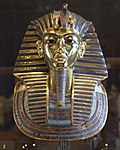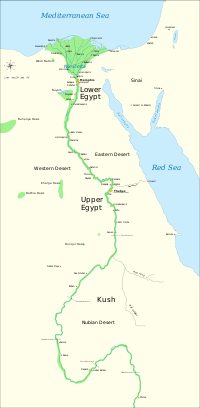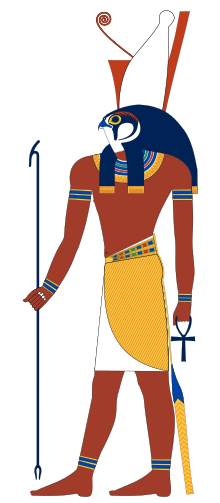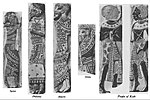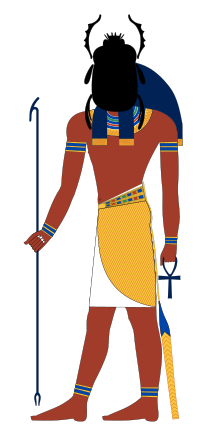Egyptian faience is a sintered-quartz ceramic material from Ancient Egypt. The sintering process "covered [the material] with a true vitreous coating"...
40 KB (4,559 words) - 22:04, 3 June 2024
as faience, but the distinction is not usually maintained. Semi-vitreous stoneware may be glazed like faience. Egyptian faience is not really faience, or...
19 KB (2,200 words) - 08:10, 21 August 2024
"William", also known as "William the Hippo", is an Egyptian faience hippopotamus statuette from the Middle Kingdom, now in the collection of the Metropolitan...
8 KB (854 words) - 20:07, 10 November 2023
spanning from Prehistoric Egypt until the Christianization of Roman Egypt. It includes paintings, sculptures, drawings on papyrus, faience, jewelry, ivories,...
154 KB (18,298 words) - 14:35, 26 August 2024
production site. Egyptian blue is closely related to the other vitreous materials produced by the ancient Egyptians, namely glass and Egyptian faience, and it...
34 KB (4,635 words) - 01:52, 6 April 2024
boats, Egyptian faience and glass technology, new forms of literature, and the earliest known peace treaty, made with the Hittites. Ancient Egypt has left...
140 KB (16,496 words) - 16:22, 26 August 2024
Frit (section Relationships with glass and faience)
a total of US$ 1.67 billion. Egyptian blue – Pigment used in ancient Egypt Egyptian faience – Type of Ancient Egyptian sintered-quartz ceramic Islamic...
24 KB (3,354 words) - 03:39, 31 July 2024
Ankh (redirect from Egyptian Cross)
found in several Egyptian words, including the terms for "mirror", "floral bouquet", and "life". The symbol often appeared in Egyptian art as a physical...
25 KB (3,129 words) - 18:32, 28 July 2024
Ptolemaic Kingdom (redirect from Egyptian Ptolemies)
Kingdom, sometimes used Egyptian iconography as it had been used previously, and sometimes adapted it. For example, the faience sistrum inscribed with...
99 KB (12,336 words) - 19:24, 12 August 2024
Underglaze (section Ptolemaic faience)
china painting, blue and white pottery, tin-glazed pottery, maiolica, Egyptian faience, Delftware. In modern times a wider range of underglaze colours are...
18 KB (2,242 words) - 18:15, 8 July 2023
ancient Egypt Amarna art Ancient Egyptian pottery Egyptian faience Funerary art in Ancient Egypt Painting in Ancient Egypt Portraiture in Ancient Egypt Sculpture...
21 KB (2,258 words) - 12:31, 26 August 2024
Bes (category Egyptian gods)
the god Bes, blue Egyptian faience, between 1540 and 1076 BC, New Kingdom. Museo Egizio, Turin. Amulet of Bes; 1070–712 BC; faience; height: 3.7 cm; Metropolitan...
15 KB (1,812 words) - 17:18, 8 July 2024
Scarab (artifact) (category Egyptian amulets)
were generally either carved from stone, or molded from Egyptian faience, a type of Ancient Egyptian sintered-quartz ceramic. Once carved, they would typically...
33 KB (3,761 words) - 22:46, 24 July 2024
lazuli (imported from Badakhshan in what is now Afghanistan), and Egyptian faience were used ornamentally, and the cosmetic palettes used for eye paint...
58 KB (7,590 words) - 19:00, 15 August 2024
Horus (redirect from Har (Egyptian religion))
(/hɔːrəs/), also known as Hor (/hɔːr/), in Ancient Egyptian, is one of the most significant ancient Egyptian deities who served many functions, most notably...
41 KB (4,568 words) - 16:08, 9 August 2024
Amulet (section Ancient Egypt)
most common material for such amulets was a kind of ceramic known as Egyptian faience or tjehenet, but amulets were also made of stone, metal, bone, wood...
54 KB (6,578 words) - 09:02, 4 August 2024
Cypriote Cylinder Seals. Egyptian cylinder seals. Predynastic Egyptian Naqada era tombs and graves (imported). Egyptian Faience; see Pepi I ext link. Hittite...
17 KB (1,745 words) - 07:08, 12 July 2024
Ushabti (redirect from Egyptian shabtis)
terracotta, metal, glass and, most frequently, glazed earthenware (Egyptian faience). While ushabtis manufactured for the rich were often miniature works...
13 KB (1,527 words) - 22:14, 8 August 2024
Land of Punt (category Geography of ancient Egypt)
at Gash Group sites, many Egyptian pottery vessels and Egyptian faience beads were found, indicating close contacts with Egypt. Found Red Sea shells demonstrate...
36 KB (3,875 words) - 12:34, 26 August 2024
The Gayer-Anderson cat; British Museum Blue Egyptian faience cat figurine dated to 1981−1802 BC Ancient Egypt portal Cats portal Islam and cats Cultural...
33 KB (3,609 words) - 23:16, 22 July 2024
ingredient for making a distinct color called Egyptian blue, and also as the flux in Egyptian faience. It was used along with sand and lime in ceramic...
14 KB (1,475 words) - 21:34, 24 April 2024
Ancient Egyptian clothes refers to clothing worn in ancient Egypt from the end of the Neolithic period (prior to 3100 BC) to the collapse of the Ptolemaic...
14 KB (1,493 words) - 01:51, 22 February 2024
Ancient art (section Egypt)
favored in Egyptian art for the previous 1700 years. After Akhenaton's death, however, Egyptian artists reverted to their old styles. Faience that was produced...
63 KB (7,485 words) - 12:40, 15 August 2024
Blue pigments (section Egyptian Blue)
of ancient Egypt (c. 2613 to 2494 BC). Egyptian blue is responsible for the blue colour seen very commonly in Egyptian faience. Egyptian blue Temple...
20 KB (2,218 words) - 20:14, 28 June 2024
Ramesses III prisoner tiles (category Ancient Egyptian pottery)
The Ramesses III prisoner tiles are a collection of Egyptian faience depicting prisoners of war, found in Ramesses III's palaces at Medinet Habu (adjacent...
11 KB (1,504 words) - 00:35, 26 August 2024
Kerma (category Cities in ancient Egypt)
Nile - Ancient Egyptian Faience, London: Thames & Hudson, 1998, 46-49) De Mola, Paul J. "Interrelations of Kerma and Pharaonic Egypt". World History...
21 KB (2,589 words) - 02:14, 27 August 2024
Khepri (category Egyptian gods)
Khepri (Egyptian: ḫprj, also transliterated Khepera, Kheper, Khepra, Chepri) is a scarab-faced god in ancient Egyptian religion who represents the rising...
17 KB (1,978 words) - 23:49, 1 August 2024
Multiple examples of monochrome artworks throughout history: an Ancient Egyptian faience statuette of Isis and Horus, 332–30 BC; a gold Tairona pendant, 10th–16th...
9 KB (907 words) - 20:22, 16 February 2024
Ancient Egyptian History Archived 14 June 2020 at the Wayback Machine: from This Is Egypt | Information about Ancient Egyptian History Ancient Egyptian History...
80 KB (8,797 words) - 17:34, 27 August 2024
Dung beetle (section Ancient Egypt)
Egyptian religious and funerary art. Excavations of ancient Egyptian sites have yielded images of the scarab in bone, ivory, stone, Egyptian faience,...
41 KB (4,700 words) - 19:43, 30 July 2024




